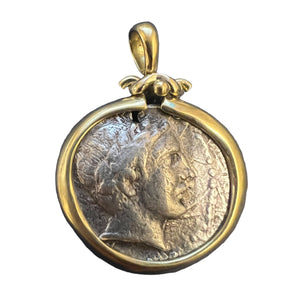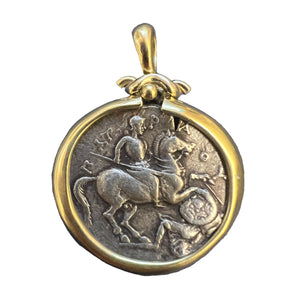Apollo - Ancient Greek - AR Tetradrahm - Kings of Pannonia (Patraos) - Circa 335-315 BCE
$3,950
Mint: Paeonia (Modern day Bulgaria)
Date: Circa 335-315 BCE
Mount: 18K gold
Weight: 12.84 gm ( 23mm, 12 h)
Denomination: Tetradrahm
Grade: VF
Description: KINGS OF PAEONIA. Patraos, circa 335-315 BC. Obverse: Laureate head of Apollo to right. Reverse:. ΠΑΤΡΑΟΥ Paeonian horseman, wearing crested helmet and full armor, galloping right and spearing fallen enemy. Lightly toned. Struck from a worn obverse die and with a minor test cut on the edge, otherwise, very fine.
History: Paeonia was located in ancient Macedonia (mostly modern-day Bulgaria). The peony flowering plant (genus Paeonia) derives from the name Paeonia. In antiquity, Paeonia /piːˈoʊniə/ (Greek: Παιονία) was the land and kingdom of the Paeonians (Greek: Παίονες).
In the Illiad the Paeonians are said to have been allies of the Trojans. During the Persian invasion of Greece the conquered Paeonians as far as the Lake Prasias, including the Paeoplae and Siropaiones, were deported from Paeonia to Asia. The 355-354 BC, Philip II took advantage of the death of King Agi of Paeonia and campaigned against them in order to conquer them.
The Greek god Apollo is often shown as a young man with a laurel wreath, and is one of the Twelve Olympians. He is the son of Zeus and Leto and the twin brother of Artemis. He was the god of healing and medicine, of music and poetry, and was the leader of the Muses. He also was a god of revenge and justice. He was closely associated with the art of music.




